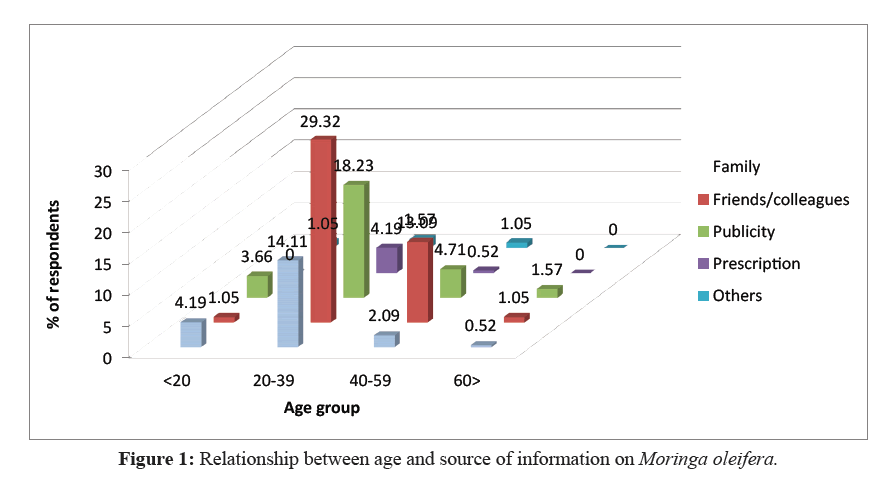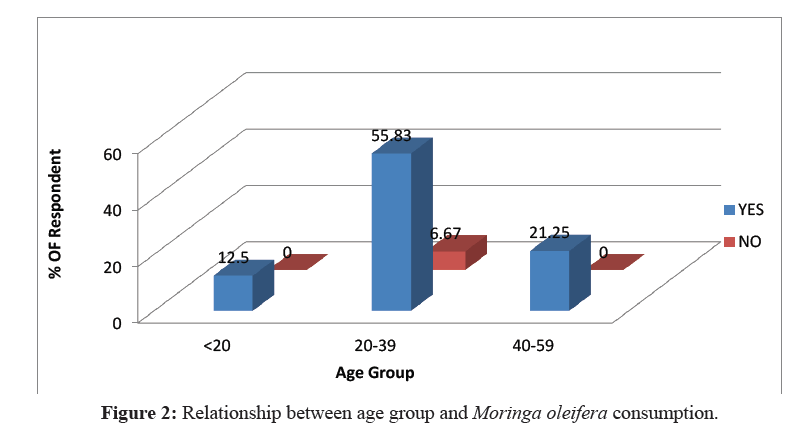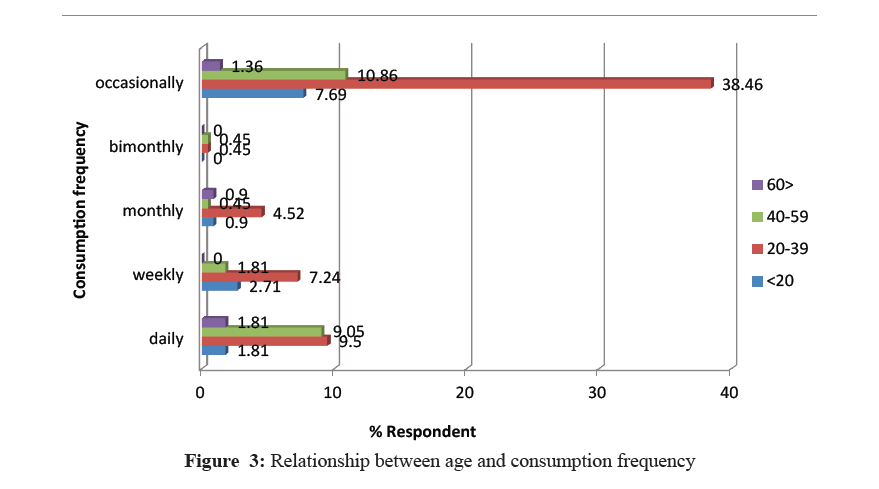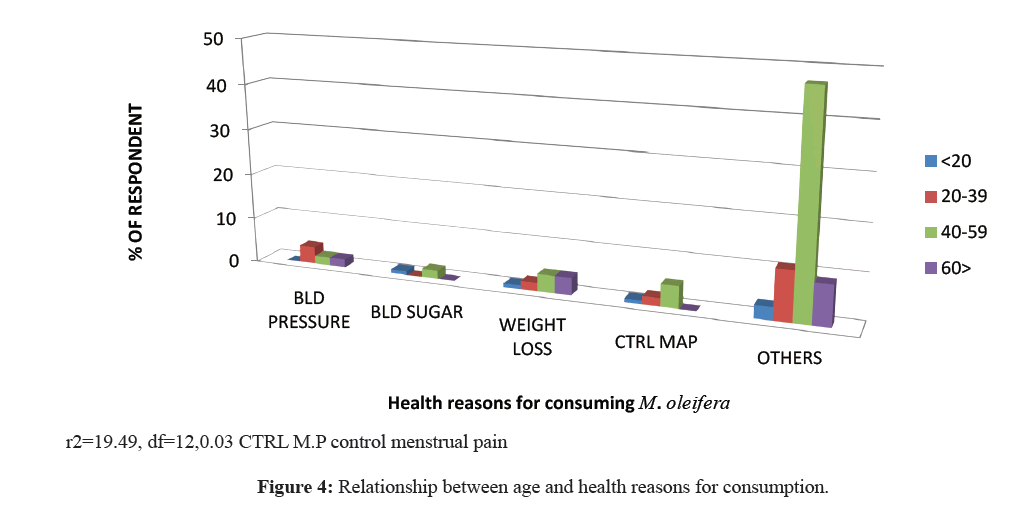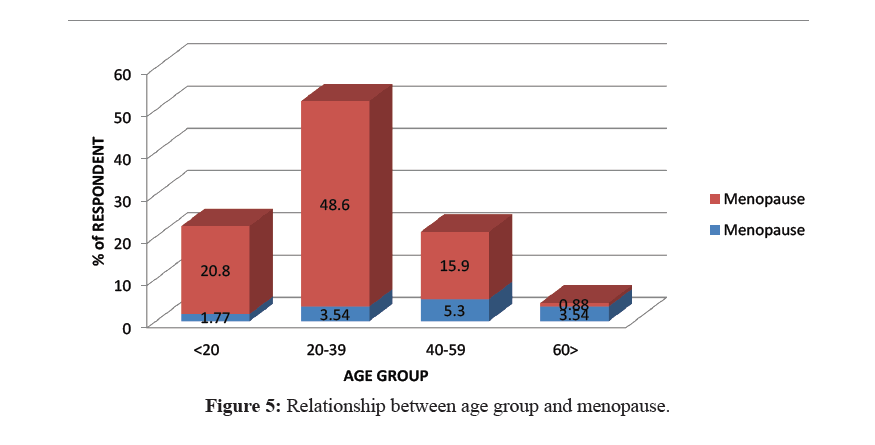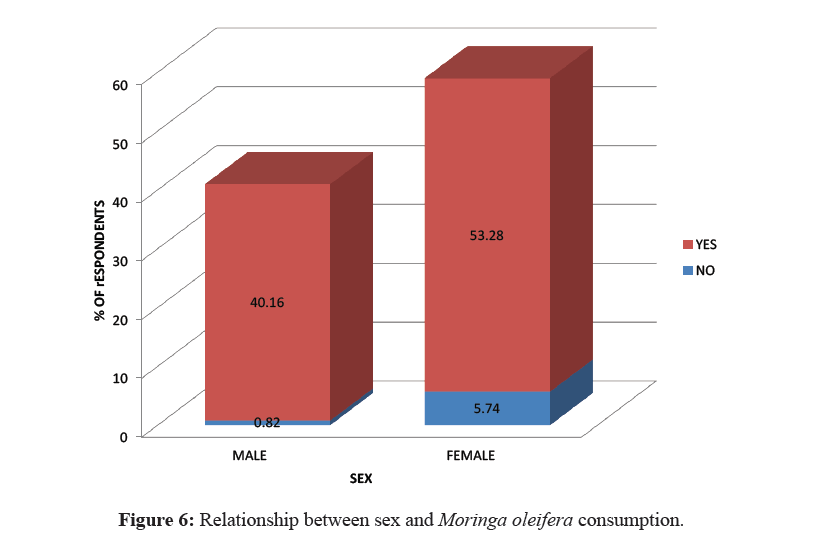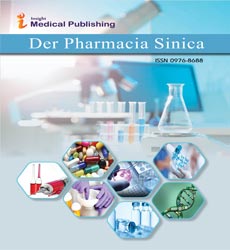ISSN : 0976 - 8688
Der Pharmacia Sinica
Estrogenic Modulation and Haematological Profile of Moringa oleifera Consumers in Nsukka Urban Enugu State Nigeria
Otitoju O1*, Nwamara JU2 and Otitoju GTO2
1Department of Biochemistry, Federal University Wukari, Taraba State
2Department of Home-Science, Nutrition and Dietetics, University of Nigeria, Nsukka Enugu State, Nigeria
Abstract
Recent studies have shown that Moringa olieifera negatively affects the fecundity of wistar rats. This research is aimed at studying the estrogenic and haematological profile of Moringa oleifera consumers in Nsukka. Approximately 250 questionnaires were distributed. Responses on their personal data and consumption pattern were obtained and analyzed statistically using SPSS version 18. The result from this work affirms that Moringa oleifera is known and consumed in Nsukka Urban, most amongst age group 20-39, with the most prevalent source of information been from friends and colleague and highest consumption was found amongst females (53.28%). The result shows that estrogen level in the respondents was higher than the reference value, but values for haematology tests were within reference ranges. In conclusion, the result shows that consumption of M. oleifera products resulted to an increase in estrogen level in male and female but maintains a healthy production of blood cells.
Practical abstract
Some consumers of moringa in Nigeria have complained of perceived imbalance in their reproductive behaviours and functions, a problem that requires concerted efforts by nutritionists, medical personnel and life scientists. The research approach in unraveling this claim is important to meaningful economic and health development of any nation. The results of this study shows that consumers of moringa and or its products span through all socio-economic strata and are majorly between the ages of 20-39 years old. This is an important socio-economic group that is also a reflective of the reproductively active age. Therefore awareness on the reproductive implications of moringa consumption should be created among this important age group in order to minimize losses due to imbalance in their nutrition and health.
Keywords
M. oleifera, Consumption, Estrogen, Haematological indices, Fecundity.
Introduction
The use of medicinal plants in most developing nations is a development that has attracted more concerns among health workers and researchers. Moringa oleifera tree is a rapid growing plant of about 13 m tall and 35 cm in diameter [1]. In Nigeria, this plant is seen as a curative agent to virtually all ailments among the populace. It is been use as purgative, antihypertensive, antifertiliy, antidiabetic, antifibroid agent among many other uses [2-4]. Many researchers have also reported that Moringa oleifera oil and micronutrients contain antitumor, antiepileptic, antidiuretic, anti-inflammatory and venomous bite characters [5,6]. Oral information among many of its users indicates that M. oleifera is a potent blood booster and this property is being exploited in the treatment of anemia especially in vulnerable groups like women and children.
Anemia is a widespread public health problem associated with an increased risk of morbidity and mortality, especially in pregnant women and young children [7,8]. Among the numerous factors, both nutritional and non-nutritional that contribute to the onset of anemia is iron deficiency.
Similarly, the use of medicinal plants in the treatment of myriads of disease conditions including anemia in women and children could significantly reduce maternal and infant morbidity. It would also enhance intellectual and work capacity, thereby improving family, community and national socioeconomic development [9]. Against this background, we examined the effects of M. oleifera leaf extract on some haematological parameters and also on the serum estrogen levels in volunteer consumers.
All parts of the Moringa tree are edible and have long been consumed by humans [10]. In developing countries, Moringa has the potential to improve nutrition, boost food security, foster rural development, and support sustainable land care. M. oleifera leaves have been reported to be a valuable source of macro and micro nutrients, being a significant source of beta-carotene, vitamin C, protein, calcium, iron and potassium [11-13]. Moringa plant has been reported to provide nutritional, medicinal and industrial uses to man, livestock feed and crop nutritional benefits [12]. It is increasingly becoming popular for use as food supplements especially by nursing mothers, as a weaning food for children due to its nutritional benefits. It has been reported to contain more than 92 useful compounds; including 46 antioxidants, 36 anti-inflammatory constituents, 18 amino acids and 9 essential amino acids [13,14]. There is a recent upsurge in utilization of Moringa [1] and research interest has grown tremendously in Nigeria. Most research efforts in Nigeria are on basic science, nutritional and medicinal properties and utilization of the plant [14,15]. Study on possible toxicity and reproductive effects are probably not adequately documented except our earlier work where we estimated serum testosterone levels using wistar rats [16]. Besides, there is no information in relevant literature on reported negative effects of Moringa on reproductive integrity of possible consumers. The consumption of Moringa oleifera has gone beyond therapy to basic nutrition and has led to unrestricted consumption and or use of Moringa oleifera. Therefore, this study aims to find out, if Moringa oleifera also affect reproductive hormone (estrogen levels) and haematological indices in volunteer humans subjects.
Materials and Methods
Approximately 250 questionnaires were validated and distributed to volunteers’ who consumes M. oleifera products. Responses on their personal data, knowledge and consumption pattern of M. oleifera, their medical history were obtained, coded and analyzed statistically using statistical package for social sciences (SPSS) version 18. Analysis of variance (ANOVA) was used to test the level of significance among various age groups. Descriptive statistical analysis was used to obtain the mean, percentage and frequency. Pearson’s correlation coefficient was used to calculate the relationship between variables from the questionnaire.
Questionnaire
Structured, validated and pretested questionnaire by the lecturers of the department of Home Science, Nutrition and Dietetics University of Nigeria Nsukka were distributed and appropriately filled by respondents or assisted by the Research Assistant concerning their Personal data, consumption of Moringa oleifera (form and frequency), their medical history and any noticeable change that can be traced to their consumption of Moringa oleifera.
Biochemical analysis
This was carried out to determine the serum estrogen levels and their haematological indices- Erythrocyte Sedimentation Rate, white blood cell count, Pack cell volume, hemoglobin in volunteered consumers. The estrogen level was ascertained using the Estrogen immunoassay test, while that for the haemotological indices was done using the Automated Hemolytic Analyzer.
Estrogen Immunoassay Test
An estrogen assay is an in vitro competitive immunoassay for measuring estrogen analogue that bind the respective nuclear hormone receptor.
Principle of the test
The Estradiol (E2) EIA is based on the principle of competitive binding between E2 in the test specimen and E2- HRP conjugate for a constant amount of rabbit anti- estradiol. In the incubation, Goat anti rabbit IgG- coated wells are incubated with 25 μ E2 standards, controls, patient samples, and 100 μl at room temperatures (18oC-25oC) for 90 minutes. During the incubation, a fixed amount of HRP-labelled E2 competes with the endogenous E2 in the standard, sample or quality control serum for a fixed number of peroxidase immunologically bound to the well progressively decrease as the concentration of E2 in the specimen increase.
Unbound E2 peroxidase conjugate is then removed and the wells washed. Next, a solution of TMB Reagent is added and incubated at room temperature for 20 minutes, resulting in the development of blue color the color development is stopped with the addition of stop solution, and the absorbance is measured spectrophotometrically at 450 mm. the intensity of the color formed is proportional to the amount of the unlabeled E2 of the standard versus the absorbance. The E2 concentration of the specimen and controls run concurrently with the standards can be calculated from the standard curve.
The mixture of α, β-unsaturated carbonyl compounds, (I ,II, III, IV), (0.01 mole), hydroxylamine (0.01 mole) and sodium acetate (0.1 g, 0.001 mole) were dissolved in 20 ml of ethanol was refluxed for 6 hours. The mixture was poured into ice-water and stirred using the glass-rod until the precipitate was formed, 10% of HCl drops was added. The precipitate was filtered, washed and recrystallized from ethanol. The completion of the reaction was monitored by TLC.
Results and Discussion
The result shows that Moringa oleifera (MO) is well known and consumed in Nsukka Urban amongst age group 20-59 (Figure 1) with the most prevalent sources of information been from friends and colleagues and highest consumption rate was found amongst females respondents (53.28%). The frequency of consumption of MO shows that 78.1% of the respondents between the ages of 20-59 accepted to have consumed MO regularly whereas 38.46% between the ages of 20-39 adduced to consuming MO occasionally (Figure 2). The result of daily consumption of MO (Figure 3) shows that 18.55% between 20-59 years consumed it daily. Figure 4 shows that age group 40-59 years significantly (p<0.05) consumed M. oleifera the most for other reasons not stated apart from control of blood pressure, blood sugar, weight loss or menstrual pain control.
Figure 5 shows that age group 20-39 years had significant (p<0.05) highest number of respondents 48.6% that has experienced menopause related symptoms while consuming moringa products. The result also shows that (Figure 6) 53.28% of female respondents consume M. oleifera than male respondents (40.16%).
Some changes in sexual behavior of male and female respondents that consumed M. oleifera extract were studied. The highest (76.84% males and 11.58% females) respondents indicated that they experienced high sex drive while about 10.53% of the respondents agreed to have experienced low sex drive. However, the difference in experience between males and female respondents is significant (p<0.05).
The result also shows that respondents consumed MO in the form of tea, powdered, soup, raw and some combinations of any of the forms available. However, the general result shows that 20.28% (females) and 12.9% (males) of the respondents consumed M. oleifera in its raw form.
Table 1 shows that Mean ± standard deviation for white blood cell of female respondents was 5.55 ± 1.4 g/L, while that of male respondent was 5.36 ± 1.3 g/L. Hemoglobin content of female respondents was 11.41 ± 1.04 g/L, while that for male respondent was 13.03 ± 1.12 g/L. Red blood cells (RBC) of female respondents was 4.70 ± 0.46 g/L while that for male respondents was 5.47 ± 0.67 g/L. Hematocrit value of female respondents was 40.29 ± 3.25 g/L while that for male respondents was 45.81 ± 4.18 g/L. The differences in hematocrit and platelet values were not statistically significant (p>0.05).
| Sex | Estrogen (pg/ml) | White blood cell (/l) | Hemoglobin (g/l) | Red Blood cell (/l) | Hematocrit (%) | Platelet (/l) |
|---|---|---|---|---|---|---|
| Female | 97.17 ± 23.96 | 5.55 ± 1.41 | 11.41 ± 1.04 | 4.70 ± 0.46 | 40.29 ± 3.25 | 241.31 ± 88.93 |
| Reference Value | a,b,c | 3.5-10.5 x 109 | 12.0-15.5 | 3.90-5.03 x 1012 | 34.9-44.5 | 150-450 x 109z |
| Male | 95.07 ± 26.15 | 5.36 ± 1.31 | 13.03 ± 1.12 | 5.47 ± 0.67 | 45.81 ± 4.18 | 223.69 ± 68.21 |
| Reference Value | 8.0-3.5 | 3.5-10.5 x 109 | 13.5-17.5 | 4.32-5.72 x 1012 | 38.0-50.0 | 150-450 x 109 |
| T-test sig Value | - | 0.989 | 0.632 | 0.321 | 0.241 | 0.927 |
Mean ± afollicular phase (30-100 pg/ml) bluteal phase (70-300 pg/ml) cpost menopausal (<15pg/ml).
Table 1: Serum estrogen levels and Haemotological profile of Moringa oleifera consumers in Nsukka Urban
Table 2 shows the differences in estrogenic modulations among the age groups sampled. The result shows that estrogen level (228.70 ± 42.77 pg/ml) was highest in age group 40-59 while age group >60 had the lowest value of estrogen (26.67 ± 8.33). The result revealed that estrogen level in all the respondents groups were higher than the reference value, but values for hematology tests were within reference ranges irrespective of the gender. Generally, the results show that consumption of M. oleifera products resulted to an increase in estrogen levels in males and females but maintains a healthy production of blood cells.
| Age group | Estrogen(pg/ml) | White blood cell (/l) | Hemoglobin(g/l) | Red Blood cell(/l) | Hematocrit(%) | Platelet(/l) |
|---|---|---|---|---|---|---|
| <20 | 35.0 ± 8.43 | 5.66 ± 0.88 | 12.01 ± 1.73 | 4.99 ± 0.53 | 42.13 ± 5.27 | 250.92 ± 111.91 |
| 20-39 | 71.41 ± 18.27 | 5.55 ± 1.6 | 11.98 ± 1.16 | 4.94 ± 0.60 | 42.13 ± 5.27 | 223.24 ± 70.98 |
| 40-59 | 228.70 ± 42.77 | 5.36 ± 1.31 | 12.36 ± 1.30 | 5.29 ± 1.21 | 44.24 ± 5.02 | 236.60 ± 73.57 |
| 60≥ | 26.67 ± 8.33 | 4.40 ± 0.56 | 11.30 ± 1.04 | 4.60 ± 0.15 | 39.13 ± 2.35 | 267.33 ± 47.08 |
| Reference Value | a,b,c,d | 3.5-10.5 | 12.0-17.5 x 109 | 3.90-5.72 x 1012 | 38.08-50.0 | 150-450 x 109 |
| LSD Value | - | 0.548 | 0.761 | 0.531 | 0.492 | 0.710 |
Mean ± afollicular phase (30-100 pg/ml)bluteal phase (70-300 pg/ml) cpost menopausal (<15pg/ml) d in male (8.0 35 pg/ml)
Table 2: Serum estrogen levels and Haemotological profile of Moringa oleifera consumers in Nsukka Urban based on age groups.
Discussion
Consumption of moringa oleifera products for its perceived health benefits may elicit negative signals in unsuspecting consumers among different socio-economic status. Socio-economic characteristics like age, sex, marital status, education and occupations of respondents were examined. The result shows that the highest percentage of the consumers are from the age group 20-39 years (55.83%) while 12.5% of the respondents are the age group <20 years, 21.25% from age group 40-59 years and 3.75% from age group ≥ 60 years. Similar work by Osewa et al., [17] on perception of rural dwellers on the nutritional and medicinal values of Moringa in Ido local government of Nigeria examined similar demographic indices. This implies that majority of the consumers are in their reproductive active age and can continue to enjoy the benefit of Moringa but with great caution.
The source of information vary for different respondents, the different sources of information was grouped into five sources- family, friends/ colleague, publicity, prescription and others (self- discovery, internet). Those that had family as their source of information was recorded highest (14.14%) for age group 20-39 years, and least for 60 ≥ years (0.52%), for friends/colleague the highest was recorded for age group 20-39 years (29.32%). A similar trend was recorded for publicity, and prescription. This shows that friends/colleague influence age group 20-29 years most on health matters. This is in line with the work of Osewa, et al, [17] who reported that 50% of respondents had accessed information on the utilization of Moringa from friend/relatives, 42.5% through radio 6.7% via mobile phone. In this study, information from friends/colleague/relative has a high influence on health matters.
Consumption of Moringa oleifera shows that 93.33% of respondents consume Moringa oleifera against 6.67% that do not. However the largest consumers were recorded among age group 20-39, followed by age group 40-59 years. This observation was similar to work of Kola-Oladiji et al., [18] on consumption pattern and indigenous knowledge of Moringa oleifera among dwellers of rural enclaves around Ibadan Metropolis. Majority of the respondents use Moringa because of the medicinal value attached to it, thereby supporting the result from this study about Moringa consumption.
Moringa oleifera can be consumed in diverse forms, in this study, form in which Moringa oleifera is consumed was categorized into six; tea, powder, soup, raw, leaf and seed and multiple (i.e. consumption of more than one form). It was found that raw form of consumption is the highest (33.3%) followed by multiple (19.25%) and least soup (7.04%). Tea, powder and leaf & seed were consumed at 13.15%, 13.15% and 14.08% respectively. The work done by Abdulkadir et al., [19] on ethnodietetics of Moringa oleifera leaves amongst the ethnic groups in Bida, Niger State and it’s hypoglycemic effects on Wista rats, shows that Moringa oleifera is mainly consumed as salad by Hausa and Fulani ethnic group. Another work done by Osewa, et al, [17] shows that majority of respondents (40.8%) take powdered leaves, 36.7% takes dried leaves crushed to make soup and sauces.
In studying the relationship between sex and Moringa oleifera consumption, it was found that females (53.28%) consume Moringa oleifera more than the male respondents (40.16%). Similar result from the work of Williams et al., shows that male respondents (68.3%) were more than the female respondents (31.7%). This shows that sex of consumers and consumption pattern may vary for different locations.
Moringa is consumed in different forms by humans; leaves can be eaten fresh, cooked, or stored as dried powder for many months without refrigeration, and reportedly without loss of nutritional value. Spoonful of the powder can then be added to baby food, soups and vegetables, adding nutrients but not changing the taste. This powder can be used in place of fresh leaves to make sauces, or few spoonful of the powder can be added to other sauces before serving.
Although there were no known stated reasons where consumers intentionally consumed moringa to treat or create hormonal imbalance or reproductive disruption in humans but there are reported cases among consumers indicating that moringa consumption has led to imbalance in their hormonal levels as well as low sexual drive. This report is a strong warning signal that plants and their products may not only solve human perceived health challenges but may also establish other unsuspecting ailments in the body of its consumers. Therefore, more cautions should be taken in the process of using them.
This study shows that consumers within the age of 20-39 utilize moringa products for various purposes ranging from weight control, diabetes, skin disease, vision and hematinic agent. This group (20-39 years old) is a reproductive active age but consumed moringa more than other groups of different ages. This implies that modulation of reproductive hormones in this group may pose serious challenge on the fecundity and viability of reproductive outcome. However oral interview result shows that female respondents indeed experience noticeable alteration in their menstrual cycles and suspected that it may be due to the moringa seeds and or extracts consumed over some period of time.
Alteration of Sexual drive among consumers irrespective of age was reported, amongst the male respondents, a high sex drive was recorded in 76.84% of the sampled respondents. This is in agreement with the study of Lilibeth and Glorina [20]. Similarly, Zade et al [21] reported that aqueous extract of Moringa oleifera seed altered sexual activity in male albino rats. The result from Table 2 shows that estrogen level is higher (95.07 ± 26.15) than reference value (<60 pg/ml) for male and female result was 97.17 ± 23.96 pg/ml as against the reference of 30-100 pg/ml for early follicular phase, 100-400 for late follicular phase, 60-150 pg/ml for luteal phase and <30 pg/ml for post-menopausal. M. oleifera did not decrease the estrogen level in females as compared to their corresponding reference values. Although other factors such as age and different stages of menstrual cycle in females were not considered, the results still show increased estrogen levels in both male and female respondents.
According to Anwar et al., [22] M. oleifera contain Flavonoids which are polyphenolic compounds that are ubiquitous in nature and has been reported to have contain three major varieties of phytoestrogens; coumestans, isoflavones, and lignans [23,24] reported that aqueous extract of the roots and leaf of Moringa oleifera and Moringa concanensis are effective in preventing implantation in rats. This may account for low sex drive reported by male consumers. Recent studies carried out on Wistar rats showed that Wistar rats fed 10% Moringa oleifera leaf extract had its reproduction altered and this led to the impaired fecundity in some of these Wistar rats and this effect was attributed to the intake of Moringa oleifera [11].
Nath et al., [25] reported that the some commonly used Indian abortifacient plants with special reference to their teratogenic effects in rats, found out that the leaf extract of Moringa oleifera was 100% abortive at 175 mg/kg of starting dry materials. In northern part of Nigeria, moringa is a common vegetable consumed because of its perceived blood boosting capacity. There was a general increase in heamatological parameters such as red blood cell count, hemoglobin, hematocrit and platelet counts. This implies that Moringa oleifera is a positive agent for blood production and can be useful in treating cases of anaemia. Our earlier work [16] on the aqueous extract of Moringa oleifera on some haematological indices showed that there was a significant increase in Hemoglobin, PVC, RBC, WBC count in all groups given Moringa oleifera extract. However consumers should be cautioned on the safety measure to be taken even if they must consumed moringa. It is of importance to mention that majority of the consumer are occasional consumers and so the blood parameters evaluated were within normal reference ranges. Another research carried out to access the haematological and biochemical parameters of ethanolic leaf extract of Moringa oleifera leaf on Wistar rats reveals that the ethanolic leaf extract increased the hemoglobin level and hematocrit but no change was observed for WBC [26].
Conclusion
In conclusion, Moringa oleifera is well known and consume most in its raw form; its seed is the highest part consumed and consumption pattern prevalent among occasional consumers. Its nutritional and medicinal benefits are known, but it is consumed most for its nutritional benefit as a blood booster in treating anaemic patients and in menstruating females to boost blood production after menstrual loss of blood. However, consuming Moringa oleifera indiscriminately, consistently or in large quantity can pose a negative effect of reduced estrogen production in females while in males it may increase estrogen production thereby leading to estrogen-testosterone imbalance, which can cause abdominal obesity, development of feminine figures like gynecomastia and increased risk of cardiovascular diseases.
Conflict of Interest
There is no conflict of interest among authors.
Acknowledgement
Authors acknowledged the efforts of their supervisees who helped to administer the questioneers and Mr FelixEze who analyzed the blood samples for estrogenic activity.
References
- Stevens, G.C., et al., Journal of Medicinal Plants Research, 2013. 7(13): p. 799-804..
- Fahad, A.l., et al., Journal of Food Biochemistry, 2017. 41(1).
- Mohammad, F.U., et al., Journal of Food Biochemistry, 2015. 39(4): p. 360–367.
- Stephen, A.A., et al., Journal of Food Biochemistry, 2017. 41(1).
- Peltzer, K., et al., BMC Public Health, 2008. 8(255): p. 1-14.
- Songpol, C., et al., Thai J Vet Med, 2011. 41(4): p. 417-424.
- Ekwochi, U., et al., Nigerian Journal of Paediatrics, 2014. 41(2): p. 129-132.
- World Health Organization 2017. Nutritional anaemias: tools for effective prevention and control. Geneva: pp 4-8.
- Erin, M., et al., In Nutritional Anemia.(Ed) Klaus Kraemer and Michael B. Zimmermann, 2007. 1-12.
- Fahey, J. W., Moringa oleifera: Part 1. Tress for Life Journal, 2005. 1: p. 1–33.
- Nwamarah, J.U., et al., African Journal of Biotechnology, 2015. 14(3): p. 181-186.
- Fuglie, L. J., CTA publication wageningen, 2001 Netherlands pp 117 -136.
- Olugbemi, T. S., et al., International Journal of Poultry Science, 2010. 9: p. 363-367.
- Nnam, N.M. Int. J.Food Saf. Nutr. Pub. Health, 2009. 2(2): p. 158 -164.
- Ezeamuzie, I.C., et al., Pharm. Boil., 1996. 34: p. 207-212.
- Otitoju, O., et al., Chemical and Process Engineering Research, 2014. 18: p. 26-30.
- Osewa, S.O., Greener Journal of Agricultural Sciences, 2013. 3 (12): p. 829-835.
- Kumar, P.S., et al., Int J phytomed., 2010. 2: p. 210-216.
- Abdulkadir, I.S., et al., J App Pharm., 2015. 7: p. 203.
- Lilibeth, A.C., Journal of medicinal plant research, 2010. 4(12): p. 1115-1121.
- Zade, V.S., et al., Biological Forum –An International Journal, 2013. 5(1): p. 129-140.
- Anwar, F., Phytotherapeutic Research, 2007. 21(1): p. 17-25.
- Patisaul, H.B., et al., Front Neuroedocrinol, 2010. 31: p. 400–419.
- Shukla, S., et al International Journal of Crude Drug Research, 1988. 26(1): p. 29-32.
- Nath, D., et al., Journal of Ethnopharmacol, 1992. 36(2): p. 147- 154.
- Williams, F.E., et al., Agro search, 2013. 13(11): p. 165-175.
Open Access Journals
- Aquaculture & Veterinary Science
- Chemistry & Chemical Sciences
- Clinical Sciences
- Engineering
- General Science
- Genetics & Molecular Biology
- Health Care & Nursing
- Immunology & Microbiology
- Materials Science
- Mathematics & Physics
- Medical Sciences
- Neurology & Psychiatry
- Oncology & Cancer Science
- Pharmaceutical Sciences
